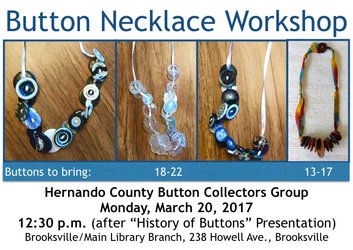
Below is a list of categories from which you can choose a favorite "H" or "I" button(s) to bring for "Show 'N Tell.". If there is not a website link with the description, you can try google-ing the term and add the word "images" to find photos of the type.
J & J Cash Company: Started in 1864 in England. Cloth-covered buttons with designs with mostly flowers, including daisy, buttercup,morning glory, chrysanthemum, rose and poppy. Also two bird designs: swallow and robin. Designs were generally woven in white fabric. 3/8”—3/4”
J.R. Gaunt & Son: From 1870s on. Company name appears on their metal buttons (mostly uniform) for American and European trade.
H. Young: American button maker before 1833. Name found on buttons.
Jacksonian: A term coined during the Andrew Jackson period. One-piece Brass, gilt finish buttons with a raised center design and plain rim turned over the edge to form a border. One hundred or more different designs include squirrels, horses, eagles, baskets, locomotives, flowers, harps, anchors and others. 1/2” — 3/4”. www.thebuttonmonger.com/content/November%202011.pdf
Japanning: Five or six layers of “synthetic lacquering” (mostly black) ornamented with gold leaf, transfer printing, stenciling and other decorations. Materials include paper ache, pewter, wood, brass and tin buttons.
Jasperware: A pottery originated by Josiah Wedgwood of England in 1700s. Very smooth pottery not needing glaze. Buttons were black, white, blue, green, lavender and brown with usually white (mostly classical) figures attached. Imitators abound. www.buttoncountry.com/Ceramics2.html
Jennings & Co.: London firm. Name can be found on Confederate buttons.
Jet: Buttons of jet appeared in early 19th century. Very scarce. Vulcanite most matches jet appearance and was used as a more-ready substitute. Glass buttons have been called “jet” but glass is much heavier and glossier. www.ebay.com/gds/Victorian-Jet-and-Other-Mourning-Jewelry-/10000000002181472/g.html
Jewel: Buttons with one stone in the center. The stone is actually molded glass or a piece of glass, most commonly. Centers are can be flat or domed or feature raised head or flower designs. Early “jewels” have round loop shanks; 20th century “jewels” have self shanks. smalls with round loop shanks we were on ladies’ basques and long loop shank “jewels’ were used on men’s vests in 19th and 20th centuries. 1/4” — 1/2.” www.buttoncountry.com/GlassInM1.html
Jeweled: 17h Century. Gemstone buttons with a jewel set in the center or in the border. Glass and paste imitations abound.
Jones, W. H.: American manufacturer of gilt buttons with name on back. 1830-32
Jordan Pearl: Buttons of hand-carved white mother-of-pearl shell made in Bethlehem in the Holy Land during the 20th century. 3/4” — 1-1/2.” www.buttoncountry.com/Shell1.html
Judds: Name found on pewter buttons, circa 1830s.
Kaleidoscope: Glass buttons with brightly colored lines or irregular patterns with a metal shank plate to protect the transfer design that had been applied to the flat back.
Kaziun, Charles: Producer of glass paperweights and paperweight buttons beginning in 1950s. First to use foil designs in paperweights. Buttons can frequently be identified by a small K in glass cane.
Key Shanks: Flat metal shank with a hole drilled in it. Most frequently found on 20th century glass buttons. www.buttoncountry.com/BackTypes1.html
Knapp Originals: Hand-painted fabric-covered buttons by Blanche Knapp in 1950s. Subjects include flowers, birds, winter and summer scenes and famous buildings. Also painted some shell buttons.
Knitted: Buttons covered with little “caps” knit with fine thread probably by machine. Few to be found.



 RSS Feed
RSS Feed